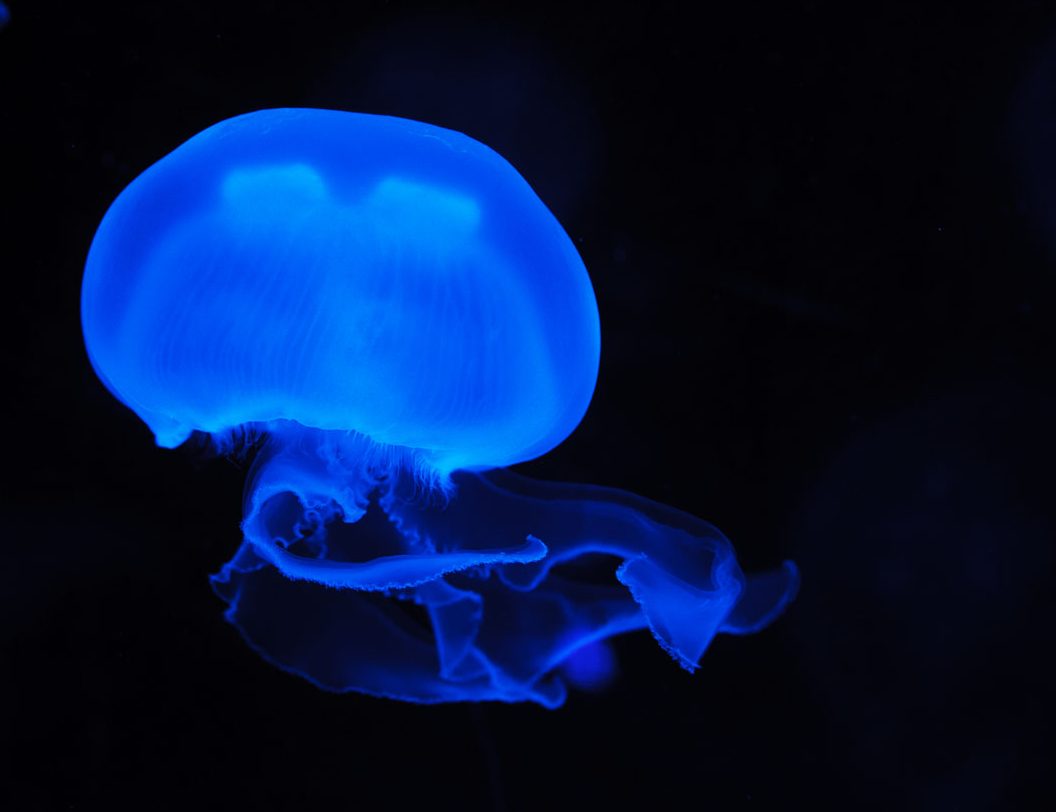JellyFish Exercises

Hello again!
I have processed the first four Jellyfish recordings and posted them via Soundcloud. As I mentioned in the previous post, the Jellyfish Exercises are a set of breathing and interoception exercises Bob developed over the last four or five years, starting when I was in still in Salt Lake City. They steadily became a regular and important practice for him; he viewed the exercise as connecting with the most fundamental fact of being alive and embodied in the world.
He also developed a very deep and subtle practice with it, turning it into a form of internal skill development, where he would listen to the smallest, most subtle movements created in the body through the act of breathing. One of the fundamental characteristics of the practices we set out to develop is that they are focused on movement and the experience of movement, rather than the enforced stillness of many classic forms of meditation.
Listening to movement is a window into our interoceptive sense, and a way of deepening our relationship with ourselves, of becoming a unified brain and body (a brainbody, in the parlance Bob preferred). The most fundamental of all movements we experience in our lives is the movement of the breath; it is among the very first we experience on birth, and its cessation marks the end of our time on this strange and glorious spinning rock.
I hope you find these exercises useful, and if you are someone who knew Bob Iden personally, perhaps you will find a comfort in taking some instruction from him one more time in this practice.
Below I have included the text of the introduction; note that it references some articles which have not yet been published; things never quite go according to plan.
Laughing Ox · The Jellyfish Series
These recordings are freely available, and can be shared and downloaded by anyone. They, and the ideas they contain, are “open source” via Creative Commons BY-NC-SA 4.0.
Hello and welcome to this introduction to the Jellyfish Practice. The specifics of the Practice itself are in the subsequent guides. This is an introduction to the Practice and recommendations on how to use those guides.
The Jellyfish Practice is focused on internal somatic awareness. Here we learn to bring conscious attention and awareness to movement, in particular the movement of breathing. Breathing is a primal, ancient process that is universal in animals. Animals were breathing long, long before humans began walking the planet and it is a core part of our brainbody. Breathing, the process of breathing, is rather unique in that it is both automatic and at least partially under conscious control. Breathing is directly linked to emotional responses and intention. Breathing occupies a unique place in our living, and as you may know, many meditation systems begin with some sort of focus on breath.
But the Jellyfish Practice is not a meditation. It is a Practice of Attention and Awareness of Experience. As a Practice, it is not something that can be finished, not something you do and then have done that. Each time we come to the Practice, it is new and a little different. What you experienced the last Practice session comes with you to this session and changes and deepens the experience: We have learned how to do this Practice a little more completely, we are a bit more aware of how much there is to experience. And a bit more able to bring a full awareness to the experience. There is a lot to understand about this notion of Practice. If you haven’t already done so, you might want to check out our article on “What is a Practice.”
This Practice is a turning of conscious awareness inward to become more aware of the universe of internal experience. Normally our conscious attention is directed outward either through conscious intent – I choose to watch a particular movie or inspect an apple I might eat or listen to someone speaking or music that I enjoy. Or, often, our attention is grabbed by a flashing neon sign, a sudden noise, some shiny trinket jumping in a store window.
But here we use take the ability to focus our attention and use it to sense our internal state. This may sound like some of the meditation systems you may have heard about but it is quite different. Meditation is often about “quieting the mind” or “stress relief” or “centering”, perhaps about connecting with the flow of universal energy or some other more or less abstract idea or higher purpose.
The Jellyfish Practice is not about anything abstract. It is about being aware of the experience of breathing. It is about the actual experience of being an embodied, living creature. This may sound simple, even trivial, perhaps not worth the effort. But there is a lot to learn here. This practice is very active and can become rather intense as one develops experience with it.
Because it takes some time and effort to learn to bring attention to the Interoceptive Report and because this Practice can be an intense experience, the practice is described in several sections with an audio guided session for each of these sections.
Use the guided sessions in sequence. The guides begin with the most basic, narrow experience of the Practice and move toward more complex and global awareness. There is always the temptation to jump into the deep end of the pool but if you do this here, you are likely miss much of the learning and experience that is possible.
Before moving from one guide to the next, please become comfortable with the current guide. Use each guided Practice as many times as needed to become comfortable with the experience. After you are comfortable with that audio, then practice without the guide.
During the guided practices, your attention is directed to several areas of your brainbody. Sometimes I will use words like “expansion” or “contraction”, rise and fall to help convey a sense of where attention is directed. But keep in mind that the actual experience of each person is, to some extent, unique. The idea is to become as aware as possible of the experience of the moment. If a term or word doesn’t quite fit with your experience, that is okay. This is about direct awareness without verbal labels or any sort of value judgments.
Because this Practice is about bringing your conscious awareness to your Interoceptive Report, ideally you should perform it as an unguided practice. If you are listening to the guide then at least part of you attention is focused externally and that detracts from your internal awareness. Feel free to practice it as many times as you need with the guide until you feel comfortable you recall all the steps in a given segment of the Practice.
A good rule of thumb is that you are ready to move to the next segment when you can Practice a segment for five to ten minutes easily without the guide. When working without the guide it is a good idea to set a timer of some sort – an egg timer or your phone alarm perhaps – for ten minutes or so. There is no counting of breaths here or other marker of time and without the guide one tends to loose track of time in the early stages of this Practice. Once you are fully comfortable with a particular guided practice, then move one to the next.
Once you have worked through each individual guide, you are ready to begin combining them into a Practice of more global awareness. This is like learning to listen to a symphony. At first there is just some overall impression of what is happening; a perhaps moving but somewhat vague encounter with the music. With practice listening and some understanding of how an orchestra does what it does, it becomes possible to direct the attention to different elements, and hear how they relate to each other.
You can have an attention that is both able to hear individual details and global enough to listen to and appreciate and experience the symphony as a whole and be aware of how the strings are playing counterpoint to the winds, how variations on a repeated melody intertwine and play off one another, how a particular conductor is expressing a specific vision of understanding. The same kind of specific and global awareness of the body can be cultivated here.
A note of caution: You know your body and general health and emotional state far better than anyone else. At no point in any of this Practice should you experience any distress or discomfort or pain. If at any point you should feel even mild discomfort, whether physical or emotional, you should discontinue the Practice immediately and consult with a health professional.
And please do not do anything but breathe normally. The breathing here is just normal, everyday breathing. Don’t exaggerate your breathing or try to breathe slowly or deeply or anything other than just normal breathing.
And please give us feedback, tell us about your experience and help improve these guides. Anything you might be able to tell us about your experience is welcome and valuable. We will certainly make every effort to reply.
So, to recap. This Jellyfish Practice is about becoming aware of the experience of breathing, just normal everyday breathing. It sounds simple but it can be an intense, focused experience of internal listening. Use the audio guides in sequence. Become comfortable with each guide before moving on to the next. The last guide contains the full sequence and should be used only after you have worked through the other guides and are quite comfortable with them.
